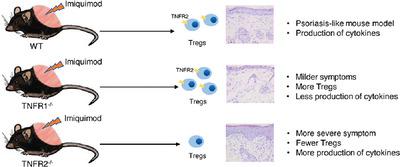当前位置:
X-MOL 学术
›
J. Leukoc. Biol.
›
论文详情
Our official English website, www.x-mol.net, welcomes your
feedback! (Note: you will need to create a separate account there.)
Differential role of TNFR1 and TNFR2 in the development of imiquimod-induced mouse psoriasis
Journal of Leukocyte Biology ( IF 3.6 ) Pub Date : 2021-09-08 , DOI: 10.1002/jlb.2ma0121-082r Shaokui Chen 1 , Zibei Lin 1 , Long Xi 1 , Ying Zheng 1 , Qiong Zhou 2 , Xin Chen 1, 3, 4
Journal of Leukocyte Biology ( IF 3.6 ) Pub Date : 2021-09-08 , DOI: 10.1002/jlb.2ma0121-082r Shaokui Chen 1 , Zibei Lin 1 , Long Xi 1 , Ying Zheng 1 , Qiong Zhou 2 , Xin Chen 1, 3, 4
Affiliation

|
Tumor necrosis factor alpha (TNF) has been implicated in the pathogenesis of psoriasis and anti-TNF therapeutics are used in the treatment of psoriasis in the clinic. However, considerable proportion of patients fail to respond to anti-TNF treatment. Furthermore, anti-TNF therapy induces de novo development of psoriasis in some patients with other type of autoimmune disorders. Therefore, further understanding of the role of TNF-TNFR signaling in pathogenesis of psoriasis remains a critical to devise safer and more effective treatment. In this study, it is shown that in imiquimod-induced mouse psoriasis model, TNF receptor type 1 (TNFR1) deficiency inhibited the development of skin diseases. In sharp contrast, TNF receptor type 2 (TNFR2) deficiency led to more severe psoriasis that was associated with increased Th1 and Th17 responses and reduced number of CD4+Foxp3+ regulatory T cells (Tregs). Importantly, adoptive transfer of WT Tregs was able to attenuate inflammatory responses in imiquimod-treated TNFR2-/- mice, suggestive of a role of malfunctioned Tregs in mice deficient in TNFR2. RNA sequencing data revealed that Tregs deficient in TNFR2 exhibited down-regulation of different biological processes linked to proliferative expansion. Taken together, our study clearly indicated that TNFR1 was pathogenic in mouse psoriasis. In contrast, through boosting the proliferative expansion of Tregs, TNFR2 was protective in this model. The data thus suggest that TNFR1-specific antagonist or TNFR2-specific agonist may be useful in the treatment of patients with psoriasis.
中文翻译:

TNFR1 和 TNFR2 在咪喹莫特诱导的小鼠银屑病发生发展中的不同作用
肿瘤坏死因子 α (TNF) 与银屑病的发病机制有关,临床上使用抗 TNF 治疗剂治疗银屑病。然而,相当一部分患者对抗 TNF 治疗无效。此外,抗 TNF 治疗可诱导新生在一些患有其他类型自身免疫性疾病的患者中发展为银屑病。因此,进一步了解 TNF-TNFR 信号在银屑病发病机制中的作用仍然是设计更安全、更有效的治疗方法的关键。在这项研究中,表明在咪喹莫特诱导的小鼠银屑病模型中,TNF 受体 1 型 (TNFR1) 缺乏抑制了皮肤病的发展。与此形成鲜明对比的是,2 型 TNF 受体 (TNFR2) 缺陷导致更严重的银屑病,这与 Th1 和 Th17 反应增加以及 CD4 + Foxp3 +调节性 T 细胞 (Treg)数量减少有关。重要的是,WT Tregs 的过继转移能够减弱咪喹莫特处理的 TNFR2 -/-小鼠,提示 Treg 功能障碍在 TNFR2 缺陷小鼠中的作用。RNA 测序数据显示,缺乏 TNFR2 的 Treg 表现出与增殖扩张相关的不同生物过程的下调。总之,我们的研究清楚地表明 TNFR1 在小鼠银屑病中具有致病性。相比之下,通过促进 Tregs 的增殖,TNFR2 在该模型中具有保护作用。因此,数据表明 TNFR1 特异性拮抗剂或 TNFR2 特异性激动剂可用于治疗银屑病患者。
更新日期:2021-09-08
中文翻译:

TNFR1 和 TNFR2 在咪喹莫特诱导的小鼠银屑病发生发展中的不同作用
肿瘤坏死因子 α (TNF) 与银屑病的发病机制有关,临床上使用抗 TNF 治疗剂治疗银屑病。然而,相当一部分患者对抗 TNF 治疗无效。此外,抗 TNF 治疗可诱导新生在一些患有其他类型自身免疫性疾病的患者中发展为银屑病。因此,进一步了解 TNF-TNFR 信号在银屑病发病机制中的作用仍然是设计更安全、更有效的治疗方法的关键。在这项研究中,表明在咪喹莫特诱导的小鼠银屑病模型中,TNF 受体 1 型 (TNFR1) 缺乏抑制了皮肤病的发展。与此形成鲜明对比的是,2 型 TNF 受体 (TNFR2) 缺陷导致更严重的银屑病,这与 Th1 和 Th17 反应增加以及 CD4 + Foxp3 +调节性 T 细胞 (Treg)数量减少有关。重要的是,WT Tregs 的过继转移能够减弱咪喹莫特处理的 TNFR2 -/-小鼠,提示 Treg 功能障碍在 TNFR2 缺陷小鼠中的作用。RNA 测序数据显示,缺乏 TNFR2 的 Treg 表现出与增殖扩张相关的不同生物过程的下调。总之,我们的研究清楚地表明 TNFR1 在小鼠银屑病中具有致病性。相比之下,通过促进 Tregs 的增殖,TNFR2 在该模型中具有保护作用。因此,数据表明 TNFR1 特异性拮抗剂或 TNFR2 特异性激动剂可用于治疗银屑病患者。











































 京公网安备 11010802027423号
京公网安备 11010802027423号